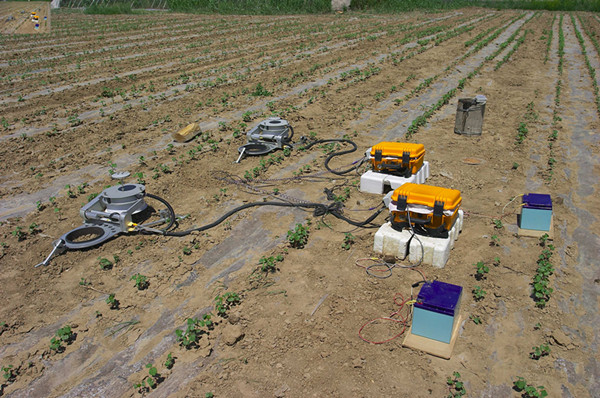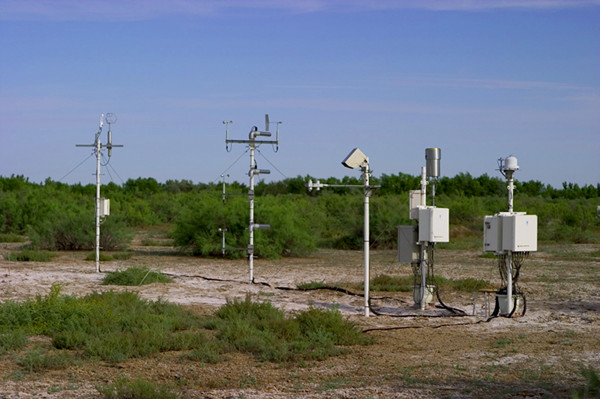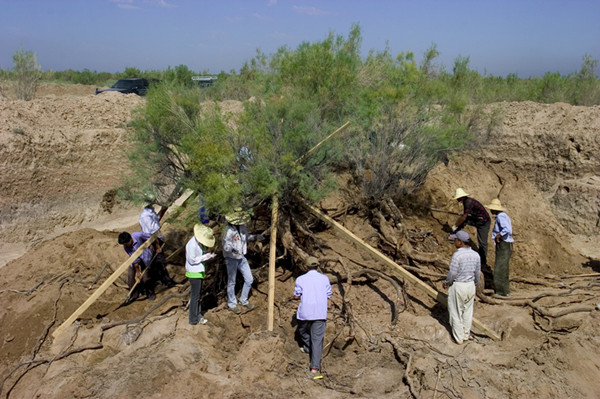Fukang National Field Scientific Observation and Research Station for Desert Ecosystems
The Station was established as part of the Chinese Ecosystem Research Network representing typical temperate desert ecosystem in 1987. It is located at the southern fringe of the Junggar Basin, the eastern Tianshan Mountains with highest Bogda Peak and the well-known Tianchi Lake. The Station is 86 km from Urumqi, with a study area covering 87o45′- 88o05′E and 43o45′-44o30′N.

The distance is only 80 km from the Bogeda Peak (5,445 m above sea level) to the Gurbantunggut Desert (460 m above sea level). In that distance the altitude decreases about 5,000 m, creating a landscape gradient from alpine glacier-snow, through mountain meadow, forest, and grassland to desert or oasis. An oasis already existed during the Han Dynasty 2000 years ago, while the new ones are only about 50 years old.
The study area covers old and new oases and the native vegetation. Three hundred and sixty nine plant species and 150 animal species have been recorded in the area, in which 25 animal species are on the national list of endangered species.
The plain area experiences a typical continental arid climate, with hot-dry summers and cold winters. The highest recorded temperature is 46oC, while the lowest is -41.6oC. Annual precipitation is around 150 mm and annual pan evaporation is around 1,000 mm. There are about 170 frost free days per year.
Research Fields
(1) Adaptation, acclimatizion and responses of plants to desert environment
(2) Salinization control and water saving in the oasis areas
(3) The carbon cycle in the arid zone, especially in the saline/alkaline land
Long-term Monitoring and Experimental Facilities
(1) Long-term monitoring of water, soil, air and biological components of desert and oasis ecosystems has been carried out since the establishment of the Station in 1987
(2) Experimental facilities and instruments include: a fixed long-term monitoring site in an oasis, a fixed long-term monitoring site in the desert, eddy-covariance system, Li-6400 photosynthesis system, Li-8150 soil respiration monitoring system, press chamber, and a laboratory for soil-plant basic property analysis
Significant Projects
(1) Biogeography-plant water relations in the temperate arid zone
The study focuses on plant-water relations, with the aim of understanding the reasons and mechanism for the self-maintaining of local excellent vegetation cover. The outcome of this study will indirectly benefit vegetation recovery or desertification control in this and similar regions.
Main study points are:
(a) Water transfer at a local scale in the Gurbantunggut Desert: sources and transferring efficiency
(b) Water use strategies of various functional groups, water use efficiency of vegetation communities
(c) Ecological significance of special eco-hydrological processes



(2) Physical and chemical mechanisms for apparent CO2 absorption by saline and alkaline soils
The basic study hypothesis is: absorption of CO2 by saline/alkaline soils is a process accompanying the salinization/alkalinization process of the soils, and thus is an on-going process that occurs in any saline/alkaline soil. The principal researchers are LI Yan and WANG Yugang.
Main study points are:
(a) The effect of physical environmental parameters on CO2 absorption
(b) The chemical processes and mechanism of this absorption
(c) The relationship between soil types and properties and CO2 absorption
(3) The ecological significance of snow-cover and snow-melting processes in Gurbantunggut Desert
The study focused on snowfall, redistribution, melting, melted water infiltration, and its relationship with plants. The principal researcher was ZHOU Hongfei.
Main study points are:
(a) Distribution of snow cover and its physical properties
(b) Snow-melting processes in the desert and its simulation
(c) The interaction between snow accumulation/melting and the local shrubs
Main Accomplishments
(1) Comparison of CO2 flux between desert and oasis, the funding of apparent CO2 absorption by saline/alkaline soils
In an experiment aimed to compare CO2 flux between desert and oasis, negative fluxes (towards soil) were frequently observed on saline desert. Further study revealed that this apparent uptake of CO2 was an inorganic/non-biological process. This negative flux was not an instrumental error. It is caused by a chemical process, and occurs in all the saline/alkaline soils that have been measured until now. On June 13, 2008, Science Magazine published a comment in their “News focus” column, titled “Have desert researchers discovered a hidden loop in the Carbon Cycle?”, which highlighted this project and its funding.
Main publication
Xie J X, Li Y, Zhai C X, et al. 2009. CO2 absorption by alkaline soils and its implications to the global carbon cycle. Environmental Geology, 56(5): 953–961.
(2) When facing strong variation in environmental conditions, desert shrubs keep rather stable physiological activity, while significantly adjusting their individual morphology
This study focused on desert shrubs such as Tamarix spp., Haloxylon ammodendron, and Reaumuria soongonica. It is known that these species had different root system distributions and water use strategies. However, it turned out that, facing strong variation in precipitation, their physiological activities remained stable. Further study revealed that individual plant response to variation in water conditions (growing in a strongly water-limited environment) was to adjust morphologically while maintaining stable physiological activities. Such plants can defoliate effectively under water stress, and grow new leaves when water conditions improve.
Main publications
Xu H, Li Y, Xu G Q, et al. 2007. Ecophysiological response and morphological adjustment of two Central Asian desert shrubs towards variation in summer precipitation. Plant, Cell and Environment, 30(4): 399–409.
Xu H, Li Y. 2006. Water-use strategy of three central Asian desert shrubs and their responses to rain pulse events. Plant and Soil, 285(1–2): 5–17.
Contact
Director : Prof. Tian Changyan
Tel : +86-991-7827367
Email: tianchy@ms.xjb.ac.cn
- Appendix
-



